5 NBA Starting Lineups in Need of a Shakeup
Grant Hughes@@gt_hughes5 NBA Starting Lineups in Need of a Shakeup

Talk all you want about the NBA embracing tactical flexibility. Cling to the notion that a team's starting five matters less than the group on the floor at the end of games. But understand something fundamental: The quality of a first unit is a pretty good proxy for the quality of the team as a whole.
If there's a weakness on the floor at the opening tip, or if certain pieces simply don't fit together, it signifies deeper issues.
Framed as a rhetorical question, do you know which teams don't have any tough decisions to make about their first units? The best ones.
Here, we'll highlight squads that either don't seem to have their starting fives hammered out, as well as a couple that should strongly reconsider the status quo.
Tinkering with first units doesn't solve everything, but it's a start.
Golden State Warriors

The Golden State Warriors aren't good enough to hold anything in reserve. That's why they should put their best possible lineup on the floor to start games, rather than holding it back for emergencies, late-game surges and desperate scenarios—like when they need to flip the momentum in a playoff series.
In the past, Golden State would typically turn to small ball and lean on the various versions of its Death Lineup in limited doses. Now that the Dubs lack a Splash Brother, have nothing close to a second superstar of Kevin Durant's caliber and can only count 36-year-old Stephen Curry as a premium shot creator, every second of every game should feel urgent. The margin for error is gone.
In camp, head coach Steve Kerr told reporters that other than Curry's starting point guard job, the other first-unit slots were up for grabs. Presumably, Draymond Green has a firm grip on one of the four open positions. He's too vital to the team's defense and facilitation to leave on the bench, and it's impossible to imagine a player as prideful as he is accepting a demotion.
But the starting spot he should occupy isn't power forward. It's center.
Trayce Jackson-Davis doesn't stretch the floor, Kevon Looney looked pretty close to finished as an impact player last year and new addition Kyle Anderson isn't a serious option. Green should be the man at the 5 alongside Curry, Brandin Podziemski, Andrew Wiggins and Jonathan Kuminga.
The Warriors were plus-12.5 points per 100 possessions with that quintet on the floor and went 8-5 in the 13 games it started last year.
The unit gives away size, shot-blocking and rebounding, and its success will depend heavily on Wiggins getting his game back after a dreadful 2023-24. Nobody said the Warriors had a "perfect" option.
But this one gives them their best chance to exploit opponents who can't keep up with the speed, ball movement and athleticism of a downsized group. If Green is anywhere close to the defender he's been in the past—signs from last year suggest he is—the Warriors could capitalize at the start of games and then turn to more conventional looks later.
Minnesota Timberwolves

At Minnesota Timberwolves training camp on Oct. 3, head coach Chris Finch told reporters "the plan is to have Julius Randle start at the 4."
Let's hope plans change.
Politics dictate a lot in the NBA, and Randle has a pair of All-NBA nods. He's the type of player you almost have to slot in as a starter, doubly so in the wake of a trade that brought him aboard for Karl-Anthony Towns. But Minnesota might benefit more by moving Sixth Man of the Year Naz Reid into Towns' vacated spot and letting Randle help prop up a bench with real offensive questions.
That's a tough sell based on the numbers. Lineups including starters Mike Conley, Anthony Edwards, Jaden McDaniels, Reid and Rudy Gobert merely broke even last season, posting a neutral 0.0 net rating in 417 possessions.
That said, the Wolves have playmaking in the first unit from Conley and Edwards. Randle would cramp spacing, potentially limit ball movement and make it harder for the guards to operate. Reid's shooting simply fits better.
Concerns about rookie Rob Dillingham's fitness to run backup units are legitimate. Rookies almost never contribute to winning, even when eased into their roles. Dillingham is being saddled with a very tough task as a lead playmaker, and Randle could lighten the load.
If the Wolves want to ensure they have dangerous offensive units on the floor at all times, they should allow Reid to do a KAT impression with the starters and give Randle free reign to run the show with Dillingham and Donte DiVincenzo against overmatched reserves.
New Orleans Pelicans

Lineups featuring Zion Williamson at center have their merits, though they're mostly theoretical.
Last season, the Pels stuck Williamson at the 5 for just 630 total possessions. The absence of Dyson Daniels and Naji Marshall, two pretty common components of those small-ball looks, makes it difficult to be certain how such configurations might look going forward. You'd expect uptempo offense and plenty of downhill drives into a well-spaced floor, but there's not a lot of reliable data to suggest those units can survive on D or on the boards.
Williamson showed higher activity levels on defense as 2023-24 wore on, as evidenced by dramatic spikes in his block and steal rates after the All-Star break. But for all his potential as a disruptor, Zion is an objectively poor rebounder for a forward—let alone as a center.
If he's your interior anchor as a rim-protector and glass-cleaner, you're in trouble.
That's why the call for New Orleans to add a starting center has been so consistently loud since Jonas Valančiūnas' departure in free agency.
In fairness, we don't actually know which five Pelicans will take the floor for opening tips. Neither does head coach Willie Greene, who told reporters as much at media day. Williamson, Herb Jones and Dejounte Murray should be locks in the first unit, but as the roster stands now, it appears the Pels will either go small with Williamson at the 5, include CJ McCollum over Trey Murphy III or use veteran Daniel Theis in the middle.
All of those options underwhelm.
New Orleans should trade Brandon Ingram for a center and start him next to Williamson, Jones, Murphy and Murray. McCollum could come off the bench to lead second units.
Easy enough, right?
Chicago Bulls

If we embrace the fiction that the Chicago Bulls want to field a sensible starting five (a dubious stance given the team's potential to tank), we need to acknowledge the issues with the current group.
For starters, Nikola Vučević shouldn't be involved. That'll be the case whether the Bulls intend to rebuild or pursue success.
Vooch will turn 34 during the first week of the season and still has two years left on his deal at an average annual value of $20.5 million. A defensive sieve who doesn't impact the game with his size on offense (1.7 free-throw attempts per game last year), the veteran center has no future with the Bulls and can't really help them in the present.
With a few teams in need of a stopgap big man—New Orleans, Boston, maybe even Memphis—the Bulls should be looking to offload the former All-Star for expiring salary and could even justify paying a second-rounder to dump his deal.
Beyond that, there's the Zach LaVine element to consider. A trade sending out the high-scoring guard is the shake-up this lineup is likely to see, leaving behind Josh Giddey, Coby White and Patrick Williams as the only surefire members of the first unit.
Even that group has problems, not the least of which being Giddey's need for the ball, which stands to diminish White's role in the offense. That's not exactly ideal after White broke out with a career-high 19.1 points per game in 2023-24.
Portland Trail Blazers

If the Portland Trail Blazers do things right, 60 percent of their projected starting five should be different by February.
As it stands, Scoot Henderson should get a shot to man the point with the first unit, joined by Anfernee Simons, Deni Avdija, Jerami Grant and Deandre Ayton. Henderson and Avdija are keepers, but the rest of that group should be on the trade block from the jump.
Rookie Donovan Clingan needs the reps to justify his draft slot, Shaedon Sharpe deserves a chance to prove he's the man for the job at the 2 and Toumani Camara warrants an extended look as a defensive ace who starts at the 4. All three of those young players will take their lumps, and the Blazers would probably win more games if they went forward with Simons, Grant and Ayton playing 30-plus minutes every night.
But what would be the point of that?
Portland may say it wants to pull off a leap that draws comparisons to the 2023-24 Houston Rockets, who won 19 more games last year than they did in the previous season. But even progress of that wildly unlikely degree would probably see the Blazers fall short of the Play-In.
The Utah Jazz are the only other team in the West that looks relatively feeble. Everyone else has at least semi-realistic dreams of seeing the postseason. In a year like this, Portland can't afford to spin its wheels while its veterans lose trade value by the day. Grant, Simons, Ayton, Robert Williams III and several others will bring back more in a swap the sooner they're moved, and the glut of go-for-it teams around the league creates a robust seller's market for the Blazers.
Portland needs two things this season: draft equity and information on the abilities of its youngest pieces. The way to get both involves dissolving a good portion of the current starting five.
Stats courtesy of NBA.com, Basketball Reference and Cleaning the Glass. Salary info via Spotrac.
Grant Hughes covers the NBA for Bleacher Report. Follow him on Twitter (@gt_hughes), and subscribe to the Hardwood Knocks podcast, where he appears with Bleacher Report's Dan Favale.
B/R Recommends
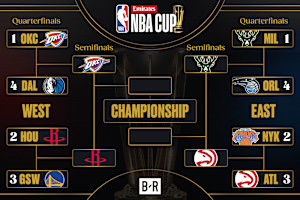
Stephen Curry, Warriors Eliminated from NBA Cup, Ripped By Fans for Loss vs. Rockets
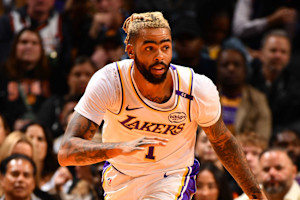
5 Early Predictions for 2024-25 NBA Trade Season
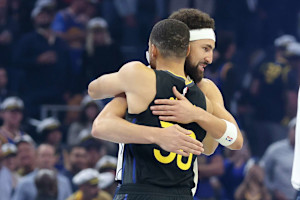
Video: Draymond Green Says Klay Thompson 'Ghosted' Steph Curry Before Mavs-Warriors

Pelicans' Zion Williamson Shows Off Full-Back Tattoo in Social Media Video
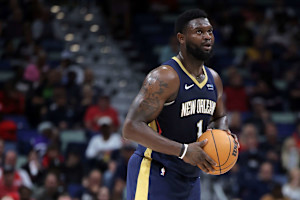
NBA Rumors: Zion Williamson, CAA Split as 'Contract Situation in Doubt' amid Injuries
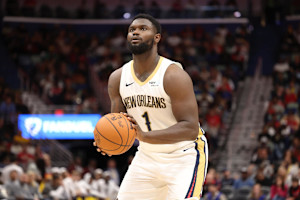
NBA Rumors: Zion Williamson Not Close to Return for Pelicans amid Hamstring Injury
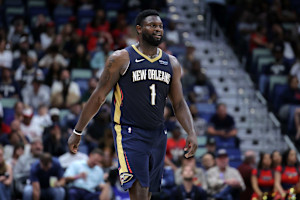
Zion Williamson Out Indefinitely for Pelicans with Hamstring Injury

Zion Williamson Out for Pelicans' Season Opener vs. Bulls with Illness

NBA Rumors: Zion Williamson Won't Be Waived by Pelicans Despite Injury Struggles

Warriors' Draymond Green on Lauri Markkanen Trade Rumors: 'That Could've Been Trash'









